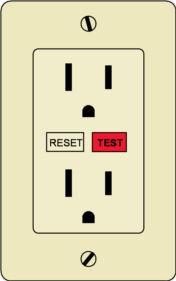Do I need a GFCI? NEC code for houses says "GFCI outlets must be installed in any area where electricity and water may come into contact...". Although recreational boats are not covered by building code, they definitely need to be protected wherever there's a risk of contact with water. A GFCI (ground fault circuit interrupter) outlet is a device that adds a greater level of safety by reducing the risk of electric shock. Most building codes now require that a GFCI outlet be used in wet locations such as bathrooms, kitchens, laundry rooms and outdoors. |
 |
A GFCI outlet monitors for a current imbalance between the hot and neutral wires and breaks the circuit if that condition occurs. A circuit breaker usually will trip if you receive a shock, but it may not act fast enough to protect you from harm. A GFCI outlet is more sensitive and acts faster than a circuit breaker or fuse and is thus an important safety feature.
A GFCI outlet may be wired in a branch circuit, which means other outlets and electrical devices may share the same circuit and breaker (or fuse). When a properly wired GFCI trips, the other devices down the line from it will also lose power. Note that devices on the circuit that come before the GFCI are not protected and are not affected when the GFCI is tripped. If the GFCI outlet is improperly wired, none of the other loads, upstream nor downstream are protected.
If you have an outlet that doesn't work, and the breaker is not tripped, look for a GFCI outlet which may have tripped. The non-working outlet may be down line from a GFCI outlet. Note that the affected outlets may not be located near the GFCI outlet, they may be several rooms away or even on a different floor.
GFCI outlets should be tested periodically, at least once a year. A GFCI outlet has a "Test" and a "Reset" button. Pressing the "Test" button will trip the outlet and break the circuit. Pressing the "Reset" will restore the circuit. If pressing the test button does not work, then replace the GFCI outlet. If the outlet does pop when you press the "Test" button, but the outlet still has power, the outlet is miswired. A miswired outlet is dangerous and it should be fixed immediately.
The are two types of GFCIs in homes, the GFCI outlet and the GFCI circuit breaker. Both do the same job, but each has different applications and limitations.
The GFCI outlet is actually a replacement for a standard electrical outlet. A GFCI is not dependent on a ground to function. It does not measure shorts to the ground, it measures the current difference between the hot and neutral wires. A sudden difference of 5 ma. or more, indicating that there is another path for the electricity to flow through will trip this device. The only downside to this is there may be some nuisance tripping in highly inductive loads like large motors or even fluorescent lamps or fixtures on the same circuit. But the newer models seem to have corrected this somewhat.
A GFCI protects any appliance plugged into it, and can also be wired to protect other outlets that are connected to it.
The GFCI circuit breaker controls an entire circuit, and is installed as a replacement for a circuit breaker on your home's main circuit board. Rather than install multiple GFCI outlets, one GFCI circuit breaker can protect the entire circuit. There is a test button and a reset button on these units. If you press the test button the reset should pop out. To reset just push the reset button in.
It is not a good idea to put all your lights on a GFCI protected circuit, so you are left in the dark if the circuit trips. 12V DC lights are a great backup for this. Generally, equipment such as refrigerators, freezers and sump pumps that cannot go without electrical power for an extended period of time without causing costly losses or property damage should not be placed on a GFCI protected circuit. GFCIs are very sensitive and are subject to nuisance tripping. GFCI receptacles don't last long outdoors even under the best of conditions - always install a good cover if you are trying to keep one outside. Be sure to test the device using the "test" button before you use one.
If you would like to use the content of these articles, please contact us.
